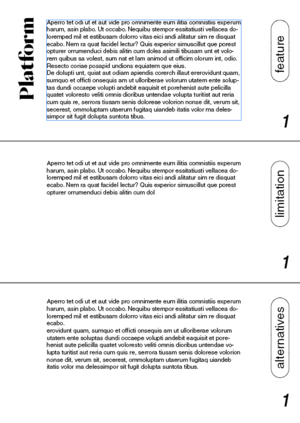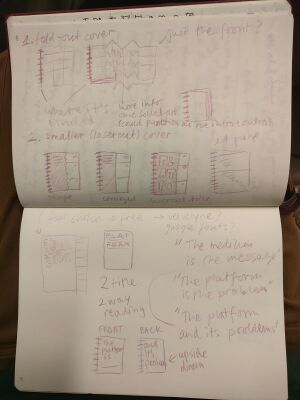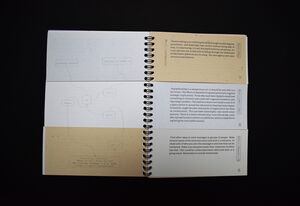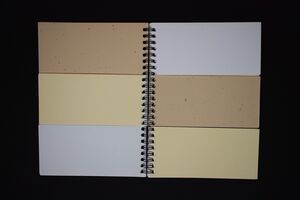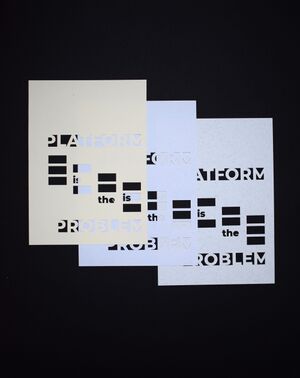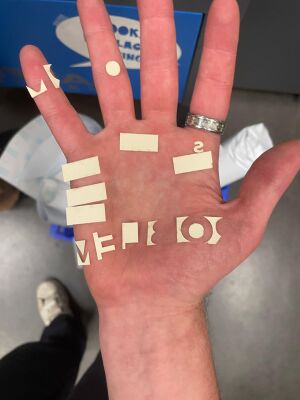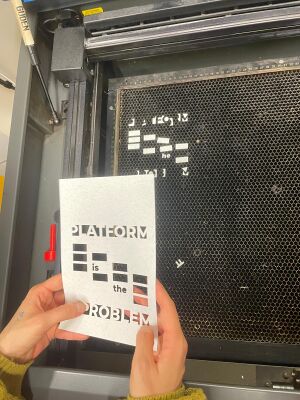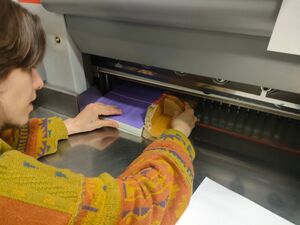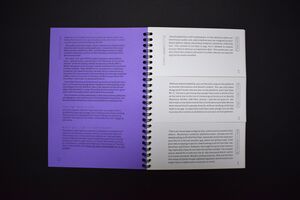Platform is the Problem: Difference between revisions
No edit summary Tag: Manual revert |
No edit summary |
||
| Line 18: | Line 18: | ||
* Three sections of: Feature (description), Implications (that the feature causes), Alternatives or See also (where we offer resources, hacks and possibilities) | * Three sections of: Feature (description), Implications (that the feature causes), Alternatives or See also (where we offer resources, hacks and possibilities) | ||
* Lasercut cover and back (the titles are cut out) | * Lasercut cover and back (the titles are cut out) | ||
* Two way reading (reading from the back is turned upside down) | * Two way reading (reading from the back is turned upside down) <br> | ||
We did not end up implementing this as it made more sense not to. Instead there where mind maps that charted down different keywords and references, which Riviera designed in LibreOffice. | |||
* Navigating elements and titles are turned 90 degrees counter clock-wise | * Navigating elements and titles are turned 90 degrees counter clock-wise | ||
* Use both Weasyprint and CSS to design the publication and the Typesetting software Riviera is familiar with. | * Use both Weasyprint and CSS to design the publication and the Typesetting software (ConTeXt) Riviera is familiar with. | ||
==Resources== | ==Resources== | ||
| Line 68: | Line 69: | ||
*Slack | *Slack | ||
*Teams | *Teams | ||
==Prototype== | |||
Spiral binding with pages cut in three makes the publication quite flimsy and delicate. The sequence of actions I took to make the dummy/prototype were: | |||
* Cut in three | |||
* Punchole | |||
* Insert spiral | |||
The paper used for the body of the book was scavenged from the streets near my house. It included many piles of different recycled and regular paper. The tricky part about working with this kind of paper is that you have to estimate what the weight is and well as if the paper is the right size. The different shades and structure of the paper made it easier to spot that you are actually sifting through different pages. Blank paper for the dummy version was added without content as well, so that we could see the full thickness the publication will have. | |||
[[File:Prototype-PITP.jpg|thumb]] | |||
[[File:Prototype-just paper.jpg|thumb]] | |||
==Lasercut Cover== | |||
Victor was working on the cover for the publication. His idea was to play with windows/tabs of platforms. We went to lasercut it together, so I can show how the machine works. | |||
[[File:Lasercut-this.jpg|thumb|Lasercuted cover tryouts with different paper]] | |||
[[File:Victor photo.jpg|thumb|Victor hand with lasercutted letters. Photo take by Victor]] | |||
[[File:Victor photo -1.jpg|thumb|Lasercut cover process. Photo taken by Victor.]] | |||
==Instructions for assembling the ''Platform is the Problem'' publication== | |||
[[File:Riviera photo-2.jpg|thumb]] | |||
Since I had work during the final production of the publication but was also the person who was the most familiar with the machines and binding types, I wrote a little instruction manual for Riviera and Victor. The minuses (-) were used for things we had already executed and the pluses (+) for things that were still to be done. <br> | |||
<br> | |||
'''Steps:''' | |||
- Print pdf <br> | |||
- Cut to A5 using the cutting machine in the Publication station: Print Studio <br> | |||
- Lasercut the cover <br> | |||
+ Cut the A5 pages (excluding the page for the introduction and colophon) in 3 equal portions vertically <br> | |||
+ Assemble each publication separately and clip it for stability. Make sure that the 3 page sections are aligned properly and that the clip covers grips 2 sections at the same time (for firmness) <br> | |||
+ Go to the whole puncher and turn it on, try it out without changing anything on a test piece of paper (eg on A4 on the shorter side). Once you have seen where does the whole puncher cut the page, take out the part of the machine that has the punchers and remove the number that's causing the problem. Then test again. Make sure that the hole will not be cutting into the page, if this happens try to align it so that it cuts the page only slightly. If you need help ask Cristobal (man with long hair in a bun) <br> | |||
+ Now go to ask for a spine-black one. Consult with them which size is best <br> | |||
+ Use the machine for binding the spine very carefully. It can crush the spiral easily. Put it on a small setting first. Manually adjust if there are any inconsistencies <br> | |||
+ Pat yourself on the back, you just produced a publication in 2 weeks. <br> | |||
==Final Version== | |||
We decided to have contrasting paper, so that the lasercut cover stands out. We produced 10 zines in total. | |||
[[File:Cover final.jpg|thumb|Cover final design]] | |||
[[File:Final intro and pages.jpg|thumb|Final look of the intro and pages]] | |||
Revision as of 13:10, 13 November 2023
Platform is the Problem
A side publication Riviera and Senka are working on (in preparation for Zine Camp). It's based on a shared dissatisfaction with how social media platforms limit and create behaviour online.
Pad of the publication [1]
Brainstorm
- USB with resources
- Script of our situation with trying to retrieve a Mixcloud file (limitation of that social media platform)
- Podcast zine - owning the infrastructure to publish stuff as an alternative
- Engraving, lindy effect and the contradictions of engraving the link
Structure
- Spiral Binding (we need to find something better than the spirals they offer at the Publication station)
- Pages cut in three equal sizes that allow for a non-linear reading
- Three sections of: Feature (description), Implications (that the feature causes), Alternatives or See also (where we offer resources, hacks and possibilities)
- Lasercut cover and back (the titles are cut out)
- Two way reading (reading from the back is turned upside down)
We did not end up implementing this as it made more sense not to. Instead there where mind maps that charted down different keywords and references, which Riviera designed in LibreOffice.
- Navigating elements and titles are turned 90 degrees counter clock-wise
- Use both Weasyprint and CSS to design the publication and the Typesetting software (ConTeXt) Riviera is familiar with.
Resources
List of Platforms
- Chatting:
- Messenger
- Telegram
- Signal
- Omegle
- Snapchat
- BeReal
- Viber
- Kik
- Content Sharing:
- Flickr
- Youtube
- Dailymotion
- Vimeo
- Tumblr
- Tik Tok
- X (Twitter)
- Streaming:
- Twitch
- Netflix
- HBO Max
- Disney +
- Spotify
- Mixcloud
- YouTube Music
- Fediverse
- Mastodon
- Forums
- 4Chan
- ?
- Discord
- Zulip
- Slack
- Teams
Prototype
Spiral binding with pages cut in three makes the publication quite flimsy and delicate. The sequence of actions I took to make the dummy/prototype were:
- Cut in three
- Punchole
- Insert spiral
The paper used for the body of the book was scavenged from the streets near my house. It included many piles of different recycled and regular paper. The tricky part about working with this kind of paper is that you have to estimate what the weight is and well as if the paper is the right size. The different shades and structure of the paper made it easier to spot that you are actually sifting through different pages. Blank paper for the dummy version was added without content as well, so that we could see the full thickness the publication will have.
Lasercut Cover
Victor was working on the cover for the publication. His idea was to play with windows/tabs of platforms. We went to lasercut it together, so I can show how the machine works.
Instructions for assembling the Platform is the Problem publication
Since I had work during the final production of the publication but was also the person who was the most familiar with the machines and binding types, I wrote a little instruction manual for Riviera and Victor. The minuses (-) were used for things we had already executed and the pluses (+) for things that were still to be done.
Steps:
- Print pdf
- Cut to A5 using the cutting machine in the Publication station: Print Studio
- Lasercut the cover
+ Cut the A5 pages (excluding the page for the introduction and colophon) in 3 equal portions vertically
+ Assemble each publication separately and clip it for stability. Make sure that the 3 page sections are aligned properly and that the clip covers grips 2 sections at the same time (for firmness)
+ Go to the whole puncher and turn it on, try it out without changing anything on a test piece of paper (eg on A4 on the shorter side). Once you have seen where does the whole puncher cut the page, take out the part of the machine that has the punchers and remove the number that's causing the problem. Then test again. Make sure that the hole will not be cutting into the page, if this happens try to align it so that it cuts the page only slightly. If you need help ask Cristobal (man with long hair in a bun)
+ Now go to ask for a spine-black one. Consult with them which size is best
+ Use the machine for binding the spine very carefully. It can crush the spiral easily. Put it on a small setting first. Manually adjust if there are any inconsistencies
+ Pat yourself on the back, you just produced a publication in 2 weeks.
Final Version
We decided to have contrasting paper, so that the lasercut cover stands out. We produced 10 zines in total.


